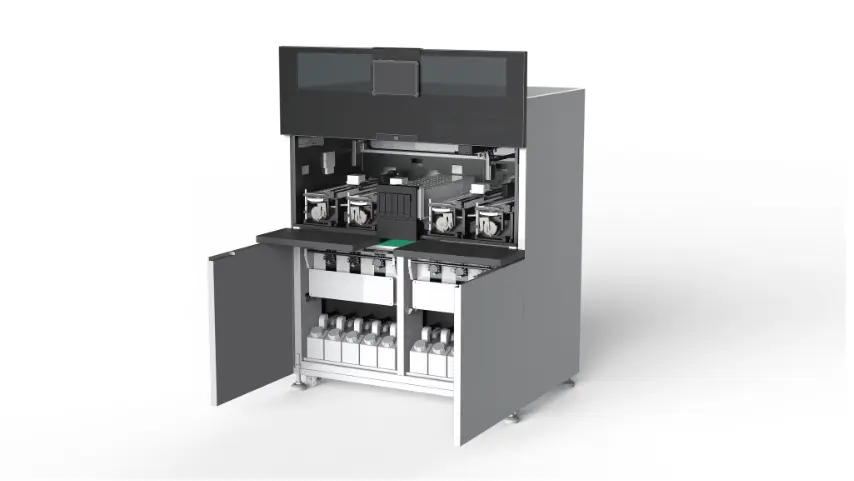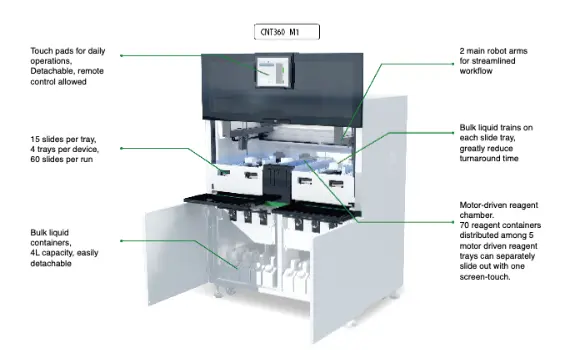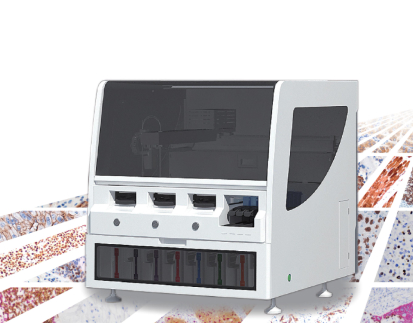IHC Stainer Outcomes: Decoding the Significance of Your Test Results
2024-10-31
By admin
Test results from an IHC stainer play a pivotal role in both diagnostics and subsequent treatment pathways. The accurate interpretation of these results can lead to tailored therapeutic strategies that align with a patient’s specific condition. Detailed analysis aids in identifying specific biomarkers, which are essential for disease classification.
The Role of IHC in Diagnostics
Immunohistochemistry (IHC) is a tool in contemporary pathology for identifying different illnesses with a focus on cancers specifically. It offers valuable information about the existence and quantities of particular proteins, in tissue samples. By using tagged antibodies, pathologists can observe where antigens are located in tissue slices, aiding in accurate disease recognition and categorization according to their molecular attributes.
Impact on Treatment Decisions
The relevance of IHC test results extends beyond diagnosis. Their influence directly impacts the decisions made regarding treatments in healthcare settings by allowing providers to choose therapies that are tailored to their needs. This decision-making process is frequently guided by analyzing the levels of biomarkers identified through IHC staining tests which can provide insights, into how a patient may respond to particular treatments. Consequently, accurate interpretation of results is necessary for optimizing patient outcomes.
What Can You Learn From Your IHC Stainer Results?
IHC stainer results provide valuable information that extends the understanding of the tumor microenvironment and cellular behavior, aiding in clinical decision-making.
Protein Expression Analysis
Through protein expression analysis, you can gain essential insights into the molecular profile of the tumor. This analysis often includes the evaluation of various key markers, which may vary depending on the cancer type. For instance, understanding the expression of proteins such as p16 or Ki67 can assist you in gauging tumor aggressiveness and potential treatment responses.
Understanding Cellular Microenvironment
Another significant aspect that you obtain from IHC results is the comprehension of the cellular microenvironment. The interaction between different cell types and their local environment can significantly influence tumor behavior and treatment efficacy. The detailed mapping of this microenvironment can also help in identifying immunological activity and therapeutic targets, facilitating personalized treatment plans.
How to Interpret IHC Stainer Results Effectively?
Interpreting IHC stainer results requires familiarity with specific markers and analysis methodologies. Not all results are created equal, and you must approach them systematically.
Key Markers to Look For
When interpreting results, identifying key markers is fundamental. Some proteins that are associated with the development or advancement of illnesses can offer information essential for diagnosis purposes. For example, the existence of hormone receptors in breast cancer might suggest suitability, for treatments. Recognizing these indicators enables strategies to be implemented when addressing different cancer-related situations.
Quantitative vs. Qualitative Analysis
It is important to differentiate between qualitative analyses to fully interpret your IHC results comprehensively. Qualitative assessments look at whether certain markers are present or absent while quantitative analysis measures the intensity and percentage of staining. By combining these two methods of analysis you can gain a deeper insight into tumor biology and identify possible therapeutic options.
Are There Common Pitfalls in Analyzing IHC Stainer Data?
Despite its utility, there are some pitfalls that you should be aware of when analyzing IHC stainer data.
Misinterpretation of Results
One significant risk involves the misinterpretation of results due to subjective factors or methodological inconsistencies. Misjudging the intensity of staining or the distribution of markers can lead to incorrect conclusions. Standardized protocols and rigorous controls must be adhered to during the staining process to mitigate these risks.
Handling Inconsistent Data
Inconsistent data poses another challenge when analyzing IHC results. Factors like tissue fixation methods or staining techniques can introduce variations in results when conducting research studies on the topic using different datasets or antibodies specificity may also play a role in this variability. Henceforth approaches to data analysis should be carried out vigilantly with validation methods and checks, in place to maintain the credibility and precision of the findings.
Solutions
You can find practical solutions for enhancing the reliability of your IHC analyses at Celnovte, where a comprehensive range of products and services is offered. By exploring advanced IHC tools like the CNT360 Full-automatic IHC&ISH Stainer, you can achieve improved accuracy and efficiency in your immunohistochemical experiments.
To sum up, assessing the outcomes of your IHC staining test involves more than just grasping the significance of these results for diagnosis and therapy; it also entails a meticulous interpretation approach. Being mindful of challenges is crucial, for making precise diagnoses and implementing successful treatment plans.
How Does Technology Improve IHC Stainer Accuracy?
Advances in Automated Equipment
Innovative technology has greatly advanced the capabilities of IHC stainers. With the introduction of fully automated equipment, such as the CNT360 Full-automatic IHC&ISH Stainer, you can expect improvements in throughput and consistency. This equipment facilitates accurate and repeatable staining results by minimizing human error and enhancing reproducibility. Thus, healthcare facilities can manage higher volumes of samples while maintaining diagnostic accuracy, leading to improved patient outcomes.
This robust automation supports not only immunohistochemical staining but also projects involving chromogenic in situ hybridization. The effectiveness of this technology allows labs to keep up with the increasing need for pathology testing services efficiently. By making use of these improvements labs can enhance their operations leading to quicker processing times for test outcomes which are essential, for prompt medical diagnosis and treatment strategies.
Software for Enhanced Data Analysis
In addition to automation, sophisticated software plays a vital role in enhancing the analysis of IHC data. Modern software applications provide advanced algorithms that facilitate the quantification and analysis of staining results. By employing such tools, you can ensure a more accurate assessment of protein expression levels, which is critical for making informed clinical decisions.
These software solutions also enable the integration of various datasets, allowing for comprehensive evaluations of tumor behavior, microenvironments, and biomarkers. Enhanced data visualization tools further assist in conveying complex information in an accessible format, promoting better understanding among medical professionals. Consequently, the synergy between automated equipment and advanced software solutions brings significant improvements to IHC testing accuracy.
What Solutions Are Available for Optimizing IHC Testing?
Innovative Solutions by Celnovte
For optimizing your IHC testing processes, Celnovte offers a range of innovative solutions designed to meet the diverse needs of the pathology community. These solutions encompass fully integrated systems that streamline workflows, enhance detection capabilities, and improve overall laboratory efficiency. With the pressure of increasing demands for diagnostic testing, utilizing products from Celnovte can lead to significant operational advantages and improve test result accuracy.
Additionally, Celnovte provides dedicated support, including training and troubleshooting assistance, to ensure you are making the most of their cutting-edge technologies. By focusing on empowerment through education and technical support, Celnovte helps you navigate the complexities of modern pathology with confidence. This ensures that your laboratory consistently produces reliable and reproducible IHC results.
Ensuring Reproducibility and Reliability
Consistency and trustworthiness play roles in the outcomes of IHC tests. The key to achieving results lies in adherence, to established procedures and the incorporation of quality assurance steps. Engaging in meticulous calibration of equipment and routinely maintaining all tools and reagents used in the staining process reduces batch-to-batch variability.
Incorporating control samples into your testing can further enhance the reliability of your results. These samples act as benchmarks, allowing you to validate the accuracy of staining and detection before proceeding with diagnostic evaluations. Consistent adherence to established protocols and regular assessments of reagent efficacy lead to high-confidence IHC results that reflect the true biological state of the samples you are working with.
Steps to Ensure Reliable IHC Stainer Test Outcomes
Proper Sample Preparation
Proper sample preparation is foundational for achieving reliable IHC stainer test outcomes. The quality of staining results greatly depends upon how tissue samples are handled. From fixing and processing to mounting them correctly is crucial for accurate outcomes, in antigen detection tests.
Furthermore, sectioning of the tissue specimens must be done with precision to ensure uniformity across samples. This meticulous approach helps to maintain the structural quality of tissues, facilitating effective staining. Moreover, performing a robust quality control step before proceeding with staining can identify any issues early, safeguarding against compromised test outcomes.
Standardized Protocols and Procedures
To achieve consistency in IHC testing, the implementation of standardized protocols and procedures is essential. Such protocols ensure that every testing phase, from staining to evaluation, adheres to specific guidelines. This not only enhances reproducibility but also minimizes variations that can arise from personal technique differences among laboratory personnel.
Continuous training for staff engaged in IHC testing plays a role in upholding protocol adherence standards. Highlighted are the benefits of evaluating and revisiting standard operating procedures (SOPs) considering recent discoveries and technological progressions to bolster the quality assurance mechanisms. Enforcing alignment among all team members with these benchmarks cultivates a sense of dependability fundamental, to the overall integrity of the IHC procedure.
To sum up things; Incorporating cutting-edge automation and advanced software into your IHC testing setup can greatly enhance the precision and speed of outcomes achieved. By embracing approaches and maintaining strict quality standards in your procedures you can successfully maneuver through the intricacies of IHC diagnostics to ensure top-notch patient care and positive clinical results.






